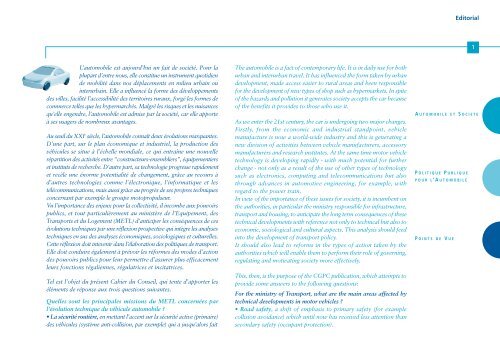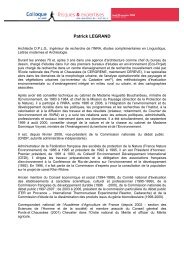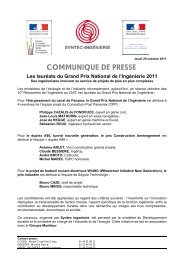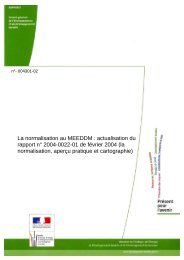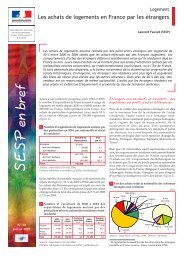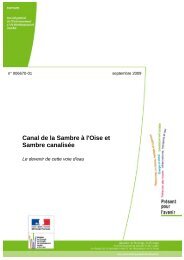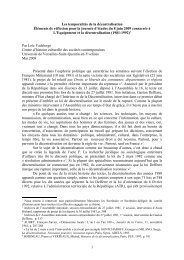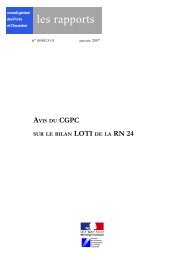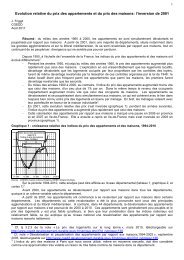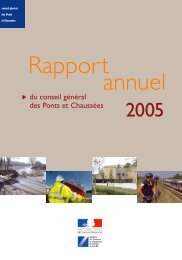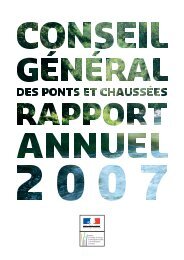Les cahiers du conseil n°3 - Automobiles et Equipement ... - cgedd
Les cahiers du conseil n°3 - Automobiles et Equipement ... - cgedd
Les cahiers du conseil n°3 - Automobiles et Equipement ... - cgedd
You also want an ePaper? Increase the reach of your titles
YUMPU automatically turns print PDFs into web optimized ePapers that Google loves.
Editorial1L’automobile est aujourd’hui un fait de société. Pour laplupart d’entre nous, elle constitue un instrument quotidiende mobilité dans nos déplacements en milieu urbain ouinterurbain. Elle a influencé la forme des développementsdes villes, facilité l’accessibilité des territoires ruraux, forgé les formes decommerce telles que les hypermarchés. Malgré les risques <strong>et</strong> les nuisancesqu’elle engendre, l’automobile est admise par la société, car elle apporteà ses usagers de nombreux avantages.Au seuil <strong>du</strong> XXI e siècle, l’automobile connaît deux évolutions marquantes.D’une part, sur le plan économique <strong>et</strong> in<strong>du</strong>striel, la pro<strong>du</strong>ction desvéhicules se situe à l’échelle mondiale, ce qui entraîne une nouvellerépartition des activités entre “constructeurs-ensembliers”, équipementiers<strong>et</strong> instituts de recherche. D’autre part, sa technologie progresse rapidement<strong>et</strong> recèle une énorme potentialité de changement, grâce au recours àd’autres technologies comme l’électronique, l’informatique <strong>et</strong> lestélécommunications, mais aussi grâce au progrès de ses propres techniquesconcernant par exemple le groupe motopropulseur.Vu l’importance des enjeux pour la collectivité, il incombe aux pouvoirspublics, <strong>et</strong> tout particulièrement au ministère de l’<strong>Equipement</strong>, desTransports <strong>et</strong> <strong>du</strong> Logement (METL) d’anticiper les conséquences de cesévolutions techniques par une réflexion prospective qui intègre les analysestechniques en sus des analyses économiques, sociologiques <strong>et</strong> culturelles.C<strong>et</strong>te réflexion doit intevenir dans l’élaboration des politiques de transport.Elle doit con<strong>du</strong>ire également à prévoir les réformes des modes d’actiondes pouvoirs publics pour leur perm<strong>et</strong>tre d’assurer plus efficacementleurs fonctions régaliennes, régulatrices <strong>et</strong> incitatrices.Tel est l’obj<strong>et</strong> <strong>du</strong> présent Cahier <strong>du</strong> Conseil, qui tente d’apporter leséléments de réponse aux trois questions suivantes.Quelles sont les principales missions <strong>du</strong> METL concernées parl’évolution technique <strong>du</strong> véhicule automobile ?• La sécurité routière, en m<strong>et</strong>tant l’accent sur la sécurité active (primaire)des véhicules (système anti-collision, par exemple) qui a jusqu’alors faitThe automobile is a fact of contemporary life. It is in daily use for bothurban and interurban travel. It has influenced the form taken by urbandevelopment, made access easier to rural areas and been responsiblefor the development of new types of shop such as hypermark<strong>et</strong>s. In spiteof the hazards and pollution it generates soci<strong>et</strong>y accepts the car becauseof the benefits it provides to those who use it.As we enter the 21st century, the car is undergoing two major changes.Firstly, from the economic and in<strong>du</strong>strial standpoint, vehiclemanufacture is now a world-wide in<strong>du</strong>stry and this is generating anew division of activities b<strong>et</strong>ween vehicle manufacturers, accessorymanufacturers and research institutes. At the same time motor vehicl<strong>et</strong>echnology is developing rapidly - with much potential for furtherchange - not only as a result of the use of other types of technologysuch as electronics, computing and telecommunications but alsothrough advances in automotive engineering, for example, withregard to the power train.In view of the importance of these issues for soci<strong>et</strong>y, it is incumbent onthe authorities, in particular the ministry responsible for infrastructure,transport and housing, to anticipate the long term consequences of thes<strong>et</strong>echnical developments with reference not only to technical but also toeconomic, sociological and cultural aspects. This analysis should feedinto the development of transport policy.It should also lead to reforms in the types of action taken by theauthorities which will enable them to perform their role of governing,regulating and motivating soci<strong>et</strong>y more effectively.This, then, is the purpose of the CGPC publication, which attempts toprovide some answers to the following questions:For the ministry of Transport, what are the main areas affected bytechnical developments in motor vehicles ?• Road saf<strong>et</strong>y, a shift of emphasis to primary saf<strong>et</strong>y (for examplecollision avoidance) which until now has received less attention thansecondary saf<strong>et</strong>y (occupant protection).A UTOMOBILE ET S OCIETEP OLITIQUE P UBLIQUEPOUR L’AUTOMOBILEP OINTS DE V UE


